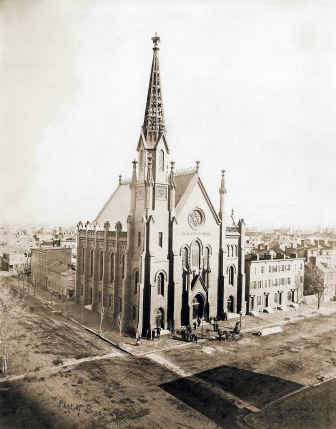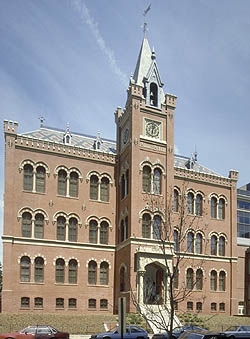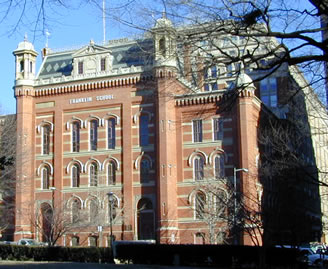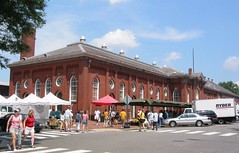Historic preservation is about beauty
 Calvary Baptist Church, 9th and H Streets NW, Washington, DC. Designed by Adolf Cluss. The steeple, lost in a hurricane windstorm a century ago, was recently replaced as part of a development agreement negotiated by the Historic Preservation Review Board.
Calvary Baptist Church, 9th and H Streets NW, Washington, DC. Designed by Adolf Cluss. The steeple, lost in a hurricane windstorm a century ago, was recently replaced as part of a development agreement negotiated by the Historic Preservation Review Board.rather than merely preserving "old buildings." Duncan Spencer, columnist for The Hill, a newspaper for Congress, captures this point for me in his column piece about Adolf Cluss, architect of many buildings in the city in the late 1800s. Most of Cluss' buildings, unlike Eastern Market, the Smithsonian Arts and Industries Building, and Franklin School, have been demolished.
From "Cluss's genius barely lives":
Take a good look at Wallach School. [Note: a large format photograph of Wallach School--from the Kiplinger Collection--is on display at Sizzling Express on the 600 block of Pennsylvania Avenue SE]
That beautiful red-brick Italianate Victorian building (which exists only in black-and-white photos) was torn down in 1950 and replaced with the charmless, crumbling, prisonlike Hine Junior High School at 7th Street and Pennsylvania Avenue S.E.
Today Wallach, with its graceful arches and its balance, would be considered one of the treasures of the neighborhood, another example of the work of that unrecognized revolutionary architectural genius Adolf Cluss, designer of the South Hall of the Eastern Market. Alas, the city chose to tear it down to build a “modern” school.
Just so, they tore down all but a few of Cluss’s more than 60 D.C. buildings, including 12 schools, churches, apartment blocks and private homes, to replace them in the main with anonymous “functional” buildings that are already ignored, scorned or forgotten.
Not only was Wallach (named after an early D.C. mayor) far more beautiful than Hine, it was built with the best materials, bronze hardware, slate steps, custom-made windows, ample decorative trim. It was Cluss’s aim to ennoble lesser public buildings and make them proud statements of the collective will of the community.
Cluss is ignored no longer, partly because of a gradual awakening to the beauties and qualities of the past, partly because of the nagging of historic-preservation groups, and partly because of a shining exhibition of Cluss work now opening in one of his finest buildings, downtown’s Sumner School, at 1201 17th St. N.W.
The Cluss exhibit commemorates the 100th year of the architect’s arrival here from Germany and is sponsored by the Charles Sumner School Museum, the German International Institute, the Goethe Insitut and the Smithsonian Office of Historic Preservation. It will run through February.
 Sumner School.
Sumner School.Sumner itself barely escaped the wrecker’s ball. In the ’60s, Washington became an artistic wasteland. Even Eastern Market was on the docket for extinction. D.C. thought the space would make a dandy parking lot. (emphasis added)
The Cluss exhibit does more than extol his six remaining major buildings, which include Franklin School at 13th and K Streets N.W., the Arts and Industries Building on the Mall, Calvary Baptist Church at 8th and H Streets N.W. and the Masonic Temple at 9th and G Streets N.W. It opens a new chapter in the history of American architecture, filling, according to art-history expert Marc Fetterman, “the great gap between the builders of the Capitol and H.H. Richardson.
”Cluss, it turns out, was way ahead of his time, breaking out of the Victorian style, freely using what he wished of the past — such as rounded arches and encrusted towers, creating daring new designs with the red brick he favored, and in every building attempting to embody the practicality and philosophical importance of democracy. Brick, he reasoned, was the material of the people — he rejected the grandiosity of marble and limestone.
___________
Beauty, craftsmanship, quality materials. That's the heart of historic preservation.
 Franklin School.
Franklin School. Eastern Market. © Keith Stanley. Used by permission.
Eastern Market. © Keith Stanley. Used by permission.



0 Comments:
Post a Comment
<< Home